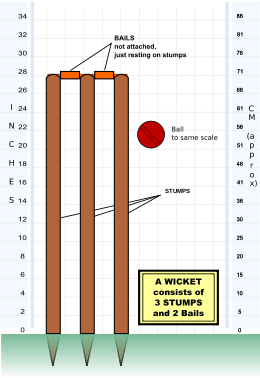Stump (cricket)

Stump is a term used in the sport of cricket where it has three meanings, part of the wicket, a manner of dismissing a batsman and the end of the day's play ("stumps").
Part of the wicket
The stumps are three vertical posts which support two bails.[1] The stumps and bails are usually made of wood, and together form a wicket at each end of the pitch.
The overall width of each wicket is 9 inches (22.9 cm). Each stump is 28 inches (71.1 cm) tall with maximum and minimum diameters of 11⁄2 inches (3.81 cm) and 13⁄8 inches (3.49 cm). They have a spike at one end for inserting into the ground, and the other end has a U-shaped 'through groove' to provide a resting place for the bails.[2] In junior cricket the items have lesser dimensions.
Each stump is referred to by a specific name:
- Off stump[3] is the stump on the off side of the wicket (the same side as the batsman's bat).
- Middle (Lie) stump[4] is the centre stump, the middle of the three stumps.
- Leg stump[5] is the stump on the on side of the wicket (the same side as the batsman's legs).
These names are relative to the batsman, so a right-handed batsman's leg stump becomes the off stump when a left-handed player is batting.
In modern professional play, the stumps are often emblazoned with a sponsor's logo. Although they are too far away from spectators to be seen, such logos are visible on television coverage.
For professional matches, often one or more of the stumps is hollow and contains a small television camera. This is aligned vertically, but can view through a small window on the side of the stump via a mirror. The so-called stump-cam gives a unique view of play for action replays, particularly when a batsman is bowled.
Manner of dismissing a batsman

In cricket, a batsman can be out stumped if:
- the wicket-keeper puts down the wicket, while the batsman is:
- out of his ground (because he has moved down the pitch beyond the popping crease, usually in an attempt to hit the ball); and
- not attempting a run.
Being "out of his ground" is defined as not having any part of the batsman's body or his bat touching the ground behind the crease - i.e., if his bat is slightly elevated from the floor despite being behind the crease, or if his foot is on the crease line itself but not completely across it and touching the ground behind it, then he would be considered out (if stumped). One of the fielding team (such as the wicket-keeper himself) must appeal for the wicket by asking the umpire. The appeal is normally directed to the square-leg umpire, who would be in the best position to adjudicate on the appeal.
Stumping is the fifth most common form of dismissal after caught, bowled, leg before wicket and run out, though it is seen more commonly in Twenty20 cricket because of its more-aggressive batting. It is governed by Law 39 of the Laws of cricket. It is usually seen with a medium or slow bowler (in particular, a spin bowler), as with fast bowlers a wicket-keeper takes the ball too far back from the wicket to attempt a stumping. It requires co-operation between a bowler and wicket-keeper: the bowler must draw the batsman out of his ground (such as by delivering a ball with a shorter length to make the batsman step forward to hit it on the bounce), and the wicket-keeper must catch and break the wicket before the batsman realises he has missed the ball and makes his ground, i.e. places the bat or part of his body on the ground back behind the popping crease. If the bails are removed before the wicket-keeper has the ball, the batsman can still be stumped if the wicket-keeper removes one of the stumps from the ground, while holding the ball in his hand. The bowler is credited for the batsman's wicket, and the wicket-keeper is credited for the dismissal. A batsman may be out stumped off a wide delivery but cannot be stumped off a no ball as bowler gets the wicket while stumping.
Notes:
- The popping crease is defined as the back edge of the crease marking (i.e. the edge closer to the wicket. Therefore, a batsman whose bat or foot is on the crease marking, but does not touch the ground behind the crease marking, can be stumped. This is quite common if the batsman's back foot is raised so that only his toe is on the ground.
- The wicket must be properly put down in accordance with Law 28 of the Laws of cricket: using either the ball itself or a hand or arm that is in possession of the ball. Note that since the ball itself can legally put down the wicket, a stumping is still valid even if the ball merely rebounds from the 'keeper and breaks the wicket, even though never controlled by him.
- The wicket-keeper must allow the ball to pass the stumps before taking it, unless it has touched either bat or batsman first. If the wicket-keeper fails to do this, the delivery is a "no ball", and the batsman cannot be stumped (nor run out, unless he attempts to run to the other wicket).
End of the day's play
Stumps is also used as a term to mean the end of a day's play, e.g. "The umpires called stumps" means that the umpires have declared play over for the day. At the end of a session, i.e. before lunch or tea, the umpires will remove the bails; at the end of the day's play, the umpires will also remove the stumps.
References
- ↑ "Stump". The Free Dictionary By Farlex. Retrieved July 11, 2012.
- ↑ "Stumps". Sports Definitions.com. Retrieved July 11, 2012.
- ↑ "Off Stump". Sports Definitions.com. Retrieved July 11, 2012.
- ↑ "Middle Stump". Sports Definitions.com. Retrieved July 11, 2012.
- ↑ "Leg Stump". Sports Definitions.com. Retrieved July 11, 2012.
| ||||||||||||||||||
| ||||||||||||||||||||||||||||||||||||||
| ||||||||||||||
